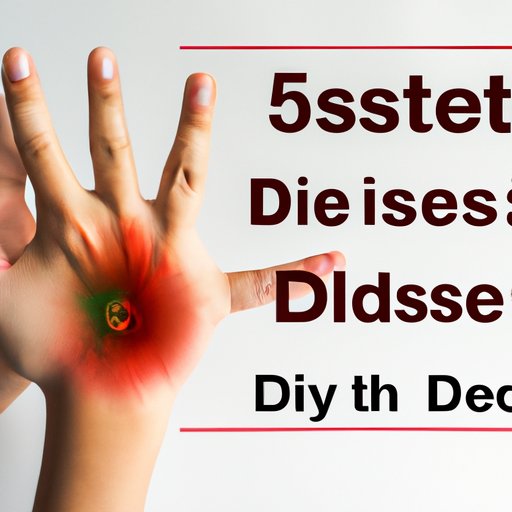
I. Introduction
5th Disease, also known as erythema infectiosum, is a common childhood illness that is caused by the human parvovirus B19. It is a highly contagious viral infection that affects children between the ages of 5 and 15, and it is commonly known as the “slapped cheek” disease due to its characteristic red rash on the face. This article aims to provide a comprehensive guide to 5th Disease, covering its symptoms, causes, treatment, and prevention. It’s targeted at parents and health professionals who want to know more about this disease and how to manage its symptoms.
II. What is 5th Disease: A Comprehensive Understanding
5th Disease is a viral illness that is caused by the human parvovirus B19. It was first discovered in 1975 and is one of the common childhood illnesses observed in children worldwide. It is typically seen in late winter or early spring and typically runs its course in about two weeks. It’s generally a mild illness that doesn’t require hospitalization.
III. The Basic Facts You Need to Know About 5th Disease
Here are some essential facts about 5th Disease that everyone should know:
- It’s contagious, and individuals can catch it by coming into direct contact with a person who has the virus.
- The incubation period is about 4-14 days, and symptoms usually show up in 8-10 days.
- The most common symptoms include fever, headache, runny nose, fatigue, and sore throat.
- Most people with 5th Disease develop a characteristic bright red rash on the face.
- It’s essential to seek medical attention if pregnant women are exposed to the disease or if they show signs of this disease, as it may lead to complications and miscarriage.
IV. Understanding 5th Disease: Causes, Symptoms and Treatment
The primary cause of 5th Disease is the human parvovirus B19, also known as the erythrovirus. It spreads through respiratory secretions such as saliva and mucus. The virus can also transmit through the blood.
One of the most distinct symptoms of 5th Disease is the “slapped cheek” rash, which often appears a few days after the initial symptoms. Other common symptoms include:
- Fever
- Headache
- Runny or stuffy nose
- Fatigue
- Sore throat
- Rash
Although there is no specific treatment for 5th Disease, most people recover within a few weeks without any complications. In cases of severe anemia, hospitalization may be required. A doctor may recommend acetaminophen dosage for pain relief and fever. Non-steroidal anti-inflammatory medications like ibuprofen are not recommended, as they have been linked to viral complications. A doctor will occasionally also prescribe antiviral drugs, depending on the severity of the illness.
V. The Impact of 5th Disease on Children: Understanding the Disease
5th Disease has little long-term side effects. However, it can have a considerable impact on young children and pregnant women. The primary risk for children is anemia, which may cause low energy levels. Individuals with weakened immune systems or underlying illnesses may have augmenting complications such as leg swelling, pneumonia, or arthritis.
VI. A Parent’s Guide to 5th Disease: Symptoms, Treatment, and Prevention
Parents can take specific steps to help their children recover from 5th Disease. For instance, ensure that your child drinks plenty of fluids and gets complete rest. Painful joints, rash, or fever are treatable with over-the-counter pain relievers, such as acetaminophen excessively.
However, if you have concerns that your child has contracted the virus, don’t hesitate to seek medical attention. Moreover, if you suspect that your child is not recovering or their symptoms are worsening, contact a doctor immediately. With ongoing research, several treatments can significantly reduce the symptoms and severity of 5th Disease. Adequate hygiene practices, such as washing hands with soap and covering the mouth and nose while coughing or sneezing, can prevent the virus’s spread.
VII. 5th Disease – A Brief Overview: Symptoms, Causes and Precautions
Here’s a brief overview of the essential things you need to know about 5th Disease:
- Caused by the human parvovirus B19
- Typically seen in children between 5 and 15 years
- The contagious period lasts for one week before symptoms develop
- Symptoms include fever, fatigue, headache, and a characteristic red rash on the face
- Preventative measures include washing hands regularly, covering the mouth during cough or sneeze, and avoiding close contact with infected individuals
VIII. How to Identify and Treat 5th Disease: Complete Guide for Parents and Health Professionals
This guide aims to help parents and health professionals understand how to identify, treat, and prevent 5th Disease. It’s an extensive guide covering all there is to know about this virus. Here’s everything we’ve covered in the sections above, summarized:
- 5th Disease is an infectious viral illness that predominantly affects young children.
- The virus is primarily transmitted by respiratory secretions or blood transfusions.
- Symptoms include fever, headache, fatigue, sore throat, runny nose, and a distinctive red rash on the face.
- There is no specific treatment available for 5th Disease, although over-the-counter medications such as acetaminophen can help with the fever and pain.
- Complications, though rare, can occur in more vulnerable individuals such as pregnant women or people with weakened immune systems.
- Preventive measures include practicing good hygiene and avoiding close contact with infected individuals.
It is advised that if you have any concerns about 5th Disease, you should contact a medical professional as soon as possible.
IX. Conclusion
In conclusion, 5th Disease is a common viral illness that affects young children and can have a considerable impact on pregnant women and people with weakened immune systems. It is highly contagious, but can be prevented by practicing good hygiene and avoiding close contact with infected individuals. While there is no specific treatment for 5th Disease, it’s essential to remain vigilant of the symptoms. Seek medical attention if you suspect that your child or anyone you know might have contracted the virus.




